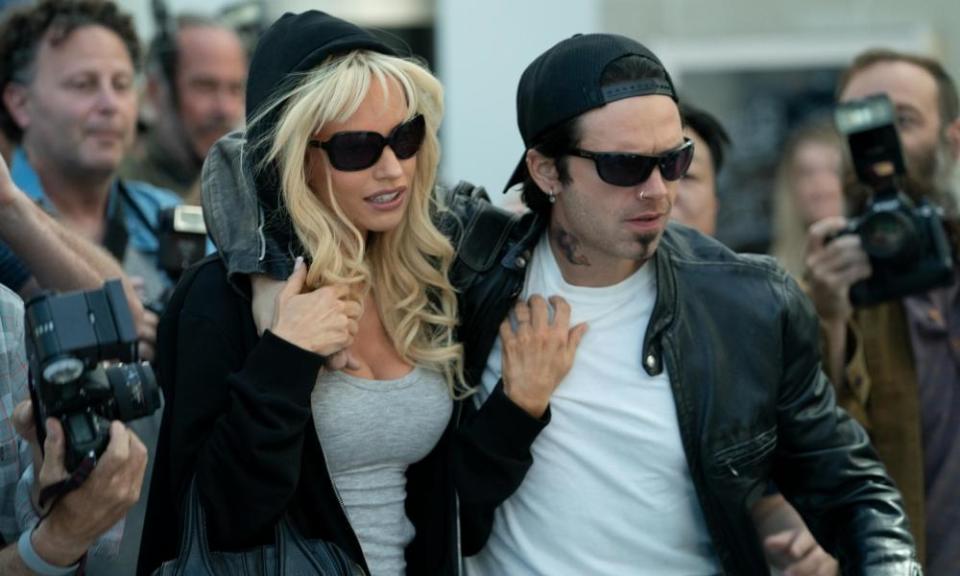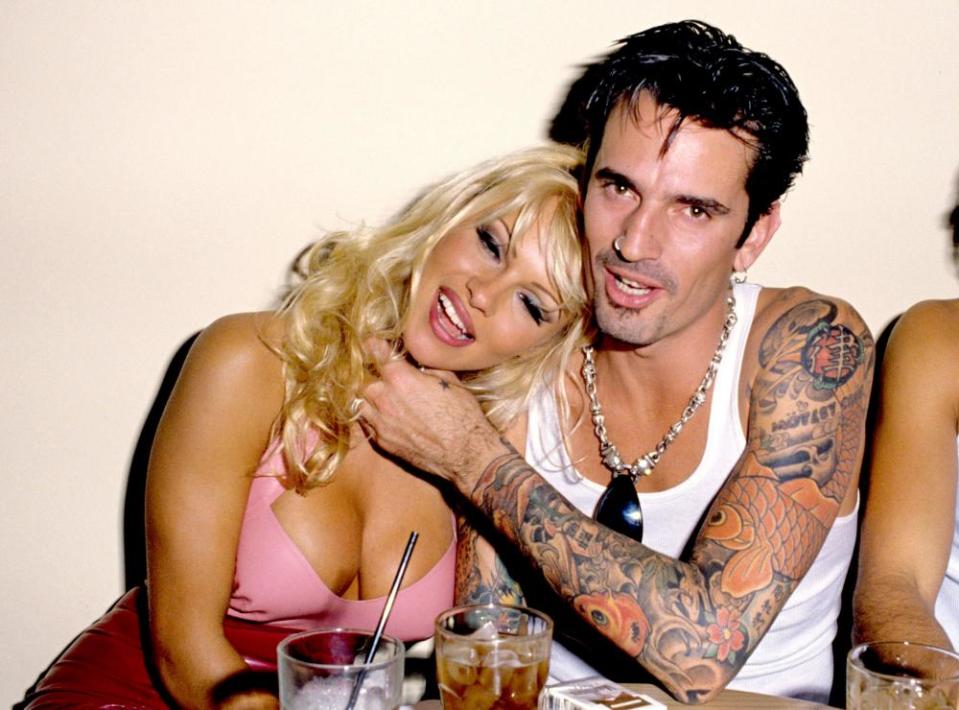The ultimate sex tape scandal: how Pam and Tommy’s stolen video shook the world
She was a cartoon beach beauty. He was a tattooed drummer. As the story of Pamela Anderson and Tommy Lee’s stolen sex tape is turned into tense TV, we remember the events that changed celebrity culture for ever
By Christmas 1995, it was moderately common knowledge that a “sex tape” existed of Pamela Anderson and Tommy Lee, privately filmed on their honeymoon that year, after a whirlwind 96-hour romance. As the star of Baywatch, Anderson was so globally famous that other, also famous TV shows had storylines about her. Lee, the Mötley Crüe drummer, was also extremely well known, mainly as a sex, drugs and rock’n’roll poster boy, partly for mooning whenever he went on stage.
Their union, and its impact, was a molecular chemistry kind of affair; like oxygen and hydrogen, each, alone, was a powerful element, but combined they were altogether more culturally powerful – her eroticism slightly neutralised by marriage, his trouble-seeking rendered a bit safer beside her all-American (actually Canadian) smile.
Let me unpack that a bit: it was the 90s. Women, even if they were gay, and definitely not if they weren’t, didn’t ogle or sanction the ogling of other women’s breasts. Men who took drugs and had tattoos didn’t get asked to endorse sports brands. The highly anticipated forthcoming Disney+ bio-series, Pam & Tommy, shows Lee in a much more unflattering light than he was seen in his heyday, but he was never thought of as a peach.
The show is a sumptuous affair, lingering on every luxurious detail of their Malibu mansion, Lee’s tattoos, Anderson’s cartoon beauty, but don’t mistake it for wealth porn (which is, of course, TV gold at the moment). His personality, her rather winning denial and inching disillusionment, tell a tense story. It’s ostensibly a caper about the sex tape and its fallout, but the simmering volatility – of Lee but also of almost everyone – creates a suspense deeper than the presence of all these celebrities would have you expect.
The sex tape, plus a load of guns and jewellery, were stolen from Lee’s safe at home just before Halloween 1995. By Christmas, it was in a Daily Mail year-in-review round-up, so everyone knew about it, but nobody had seen it. Fair play – it wasn’t until 1996 that the couple even realised the tape was missing – but there was more going on. In ways that wouldn’t become clear until much later, this was a period of tectonic shifts: from old media to new; from old to new versions of celebrity, privacy, image and brand; and from old norms around sex, porn, exhibitionism and voyeurism to new ones that still aren’t settled.
A lot of what used to make sex sleazy was in the detail. The lines between normal and kinky, clean and dirty, were drawn by the conventions of consumption; if this thing you were buying was nice, you’d be able to buy it in a nice place. Likewise, to watch this sex tape, you’d have had to send $59.95 to a Canadian T-shirt company in New York, who would then send you a VHS via Amsterdam. Or if you happened to be in the US, you’d have to know a guy who knew the guy who’d scammed the original thief, who would sell a copy straight into your hands for $175.

None of this was the kind of thing respectable people did. You would look dim if you hadn’t heard about the sex tape, but to say you’d seen it, well, you’d at least need a reason. The same couldn’t be said of sex tapes that exploded five or 10 years later – Kim Kardashian’s was leaked in 2007, Paris Hilton’s in 2003. There are so many circumstances under which you might have seen those: someone could have ironically linked to them on a chat forum, or you were just browsing. The point is, you wouldn’t need a reason. You could buy anything, anywhere, and often not even for money.
In sex terms, the fundamental collapse brought about by the internet age isn’t so much of privacy or the right to be forgotten (as EU law has it), but in a shared consensus around what sexual decency actually is, who’s allowed to have it, who’s allowed to watch it, who’s exploited by it, who’s enjoying it. The truly amazing thing is how many years have passed without bringing us any closer to a new resolution.
The Pam and Tommy story is astonishing in part because of their naivety. The series, starring Lily James and Sebastian Stan, is based on a 2014 Rolling Stone article, Pam and Tommy: The Untold Story of the World’s Most Infamous Sex Tape, which that details how, once they discovered the tape was missing, they sought to contain the leak. They sent heavies round to harass people they suspected of the theft and brought doomed lawsuits against distributors, as if the old rules were still in place and nobody could distribute your film unless you’d signed a release form. This isn’t a dumb-celeb story; their naivety was echoed across culture, subculture and the law – a sincere belief even among pornographers that if you hadn’t signed off on a film, you could prevent it from being seen.

It was a first-world problem, sure, but there was genuine crisis in the years that followed about the value of celebrity: if you couldn’t control your own content, you couldn’t monetise it, and if you couldn’t monetise it, what actually was it? Enter Paris Hilton and Kim Kardashian, with a thought experiment. They didn’t personally release their tapes, and threatened lawsuits to prevent distribution, but both ultimately went on to profit from the notoriety, having understood that the rules had permanently changed. If you don’t own the content but still own the identity, flip the equation, so the content is not rationed and the identity becomes obliteratingly large: rather than guard your privacy, show everything.
The funny thing about those sex tapes is that they don’t really work as pornography – Hilton’s is very fey, Kardashian’s is all random camera angles. But they’re not supposed to; they’re not really about sex but the body as a means of production: what can it sell? There was considerable debate in the early 00s around whether Hilton and Kardashian were the puppets or puppet-masters of the new age: in retrospect, I think it was misogynistic. If Mark Zuckerberg had done it, nobody would have asked if someone else were pulling his strings; though arguably, there would have been no mileage in him being naked. So there’s that.
Anderson and Lee’s video had a distinctive mood, in that it felt private; it was made by two people, for each other, in an age in which mass accidental distribution wasn’t on the horizon. Later, when sex tapes became more common, the question was always whether they’d been released cynically by the subject or somehow finagled by dishonest means. There was a manosphere subset who were always questing after the original Anderson/Lee experience, who didn’t want to be consumers but peeping toms.

When the great nude-dumps of the 10s came along, first in Celebgate in 2014, then in the Fappening of 2017, it was no accident they were posted on 4chan, image board of choice for the incel and other far-right misogynist movements. These were naked pictures, mostly of female actors, obtained without consent via a breach of iCloud security, and the point was that they were of stars you wouldn’t typically see naked: Jennifer Lawrence, Kate Upton. Many of the women depicted denied the authenticity of the images. The whole business was about more than naked bodies – which, let’s face it, by the middle of the last decade, you could find anywhere – it was about sticking it to women who wouldn’t put out. The Fappening was basically a metaphor for the incel identity; men who experience sex not as participants but as thieving observers, despised, marginal, illegitimate.
Pamela Anderson and Tommy Lee had two sons before divorcing in 1998. A detail that reads like a pub-quiz curiosity is that Anderson went on to marry Rick Salomon – the other party in the Paris Hilton sex video – in 2007. They got an annulment a year later, but remarried in 2014, divorcing again the year after that. (Arguably, Anderson is just very into nuptials; she managed a marriage, an annulment and another marriage to someone different during 2020, which I think puts your sourdough successes to shame.)
Regarding her and Salomon, though, it seems likely their sex tapes were an absolutely seismic, defining event for both of them, which gave them a huge amount in common. As interesting as it is, to watch privacy mutate into exposure, self into image into brand, sex into advertorial, it is monumentally asymmetrical: to the many, a curiosity; to two people, essentially the rest of their lives. It’s a reparation the world wide web will never be able to make: to rectify or even acknowledge the scale of that impact, when a billion eyes all turn to glance at the same thing at once.
Pam & Tommy is on Disney+ from 2 February.

 Yahoo Finance
Yahoo Finance 